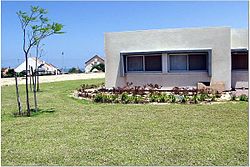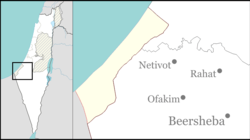This article needs additional citations for verification .(January 2009) |
Elei Sinai אֱלֵי סִינַי | |
|---|---|
Former Israeli settlement | |
 | |
| Coordinates: 31°35′01″N34°30′09″E / 31.58361°N 34.50250°E | |
| Founded | 1982 |
| Population (2004) | 389 |
Elei Sinai (Hebrew : אֱלֵי סִינַי, lit. 'Towards Sinai') was an Israeli settlement in the north of the Gaza Strip. In 2005, it had a population of 389. [1] During the Gaza war, the site came under full operational control of the Israel Defense Forces and is currently used as a military outpost.[ citation needed ]

